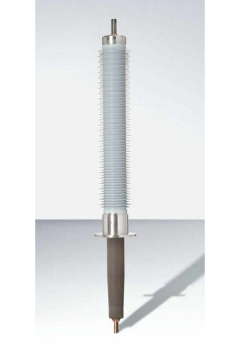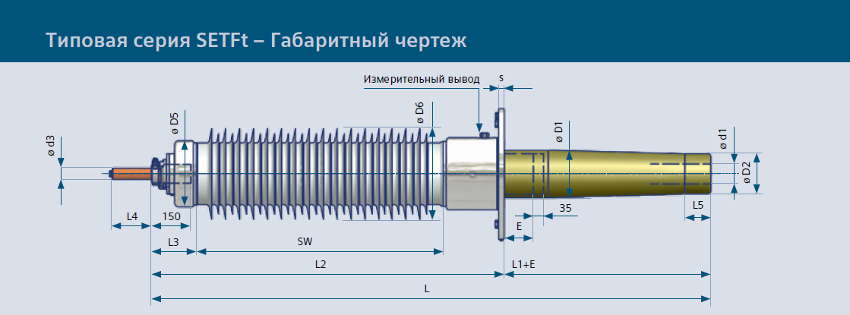Design 
The core of the capacitor high-voltage bushing consists of electrical insulating paper impregnated with epoxy resin in a vacuum, which eliminates the presence of gas inclusions in the insulation of the core. During the winding process, conductive aluminum foil plates are inserted to equalize the electric field. Thanks to the good conductivity of the aluminum foil plates, even with rapid changes in the electric field strength, its optimal distribution is ensured.
The core of electrical insulating paper in high-voltage bushings of the ETFt/SETFt series is wound on an aluminum pipe, impregnated with a compound and polymerized under vacuum at high temperatures. Giving the frame the required dimensions is carried out using turning. The core, impregnated with the compound, forms the oil-tight part of the bushing on the transformer side. Thanks to the one-piece design of the frame and current-carrying core, as well as external polymer insulation and dry filler, there is no transformer oil above the flange, which eliminates the risk of accidents associated with oil leakage and, accordingly, the risk of fire. The high temperature resistance class of high-voltage bushings with RIP insulation gives this series an additional advantage. Since these bushings are not oil-filled, there are no technological restrictions regarding the installation position. Standard high-voltage bushings are designed for installation in a position of 0 - 30° from the vertical in accordance with the IEC 60137 standard. Other installation positions are available on request.
The outer insulation consists of a composite insulating material with silicone ribs. The polymer outer cover is molded onto a fiberglass cylinder, which gives the bushing additional mechanical strength. The “polymer tire - fiberglass cylinder” assembly makes the input structure not only mechanically strong, but also flexible. Thanks to the surface having hydrophobic properties, the silicone ribs of the external insulation have good dirt-repellent ability. The hydrophobic properties are maintained even with significant contamination of the surface.
The profile with variable overhang ribs provides the possibility of using the bushing in heavily polluted environmental conditions. The polymer outer insulation is equipped with aluminum flanges on both sides, secured using a special gluing technique to ensure a strong and airtight connection. The gap between the frame and the fiberglass cylinder is filled with dry filler made of foamed polyurethane elastomer. Using a special gas foaming process, a fine cell structure of the elastomer is achieved. The cellular structure of the elastomer ensures a permanent elastic connection of the components and high electrical strength. Thanks to this design , high-voltage bushings of the ETFt/SETFt series can be used in earthquake-prone areas.
Other advantages of ETFt/SETFt inputs:
- The reduced weight of the bushing with a polymer insulator simplifies use and reduces the load on the transformer. There is no danger of scattering of fragments of external insulation in case of damage under the influence of internal or external factors. There is no possibility of damage to neighboring parts of the substation.
- Use at low ambient temperatures. Fireproof design. Long operating experience: more than 40 years.
- The flange and top of the high-voltage bushing are made of weather-resistant aluminum alloy. All O-rings are located in individual cavities and are made of temperature-resistant elastomers.
- Eliminates damage due to misuse or vandalism due to its impact resistance and earthquake resistance.
- All inputs have a measuring output. When the cap is screwed in, the last capacitor equalizing plate is grounded by means of a contact spring located in the cap.
- The built-in, insulated terminal has a 4 mm pin onto which a suitable spring bushing can be placed for measurement. All high-voltage bushings as standard have two M12 grounding holes and 01 lifting holes on the middle diameter of the flange.
- Ventilation of the transformer is provided.
 Connection systems
Connection systems
The ETFt/SETFt series offers a large number of different connection options. A contact terminal is mounted on the upper input stud, to which a current-carrying bolt or stranded wire terminal is attached. The removable cross pin connection prevents the pin from slipping into the transformer during installation and also acts as a twist preventer. To ensure the tightness of the core, double seals are provided. To prevent contact with the central input pipe, a thin layer of insulation is used, which is wound around the current-carrying core.
The contact terminal and all threaded connections at the input are made of corrosion-resistant metal. The ventilation of the central pipe is located on the side under the terminal collar and can therefore be used independently of the current-carrying core.
In addition to the above-mentioned continuous cable connection, it is possible, in the case of higher current values, to use a through conductive core - bottom connection. Such cores are isolated from the inner walls of the central pipe using spacers. Through current-carrying cores can be supplied detachable. The connector location is preferably made at flange level or according to the specific application. The use of a detachable current-carrying core simplifies the transfer of the transformer to the transport position. On the end side, the core is equipped with a threaded hole for screwing in an eye or rod for pulling through the central pipe.
Special options
The types of bushings indicated in this brochure represent standard versions. Modifications to them are possible, however, they cause possible changes in price and delivery time and therefore must be negotiated separately. Options for standard inputs are presented in the technical specifications.
Electrical screens
Inputs with a bottom connection and having a contact flange must be equipped with an electrical screen. The screens are removable thanks to a bayonet connection. They can be moved both up and down, and thereby ensure ease of installation of the contact terminal to the flange of the current-carrying core.
Pull-type bushings that do not have a contact flange and operate in the voltage range from 24 kV to 170 kV (Um) do not require a screen. However, the distance between the output channel (Ø d2) and the current-carrying core should be kept around 3mm, for example by applying suitable insulation.

CATALOG Transformer high-voltage bushings with RIP insulation SETFt series
